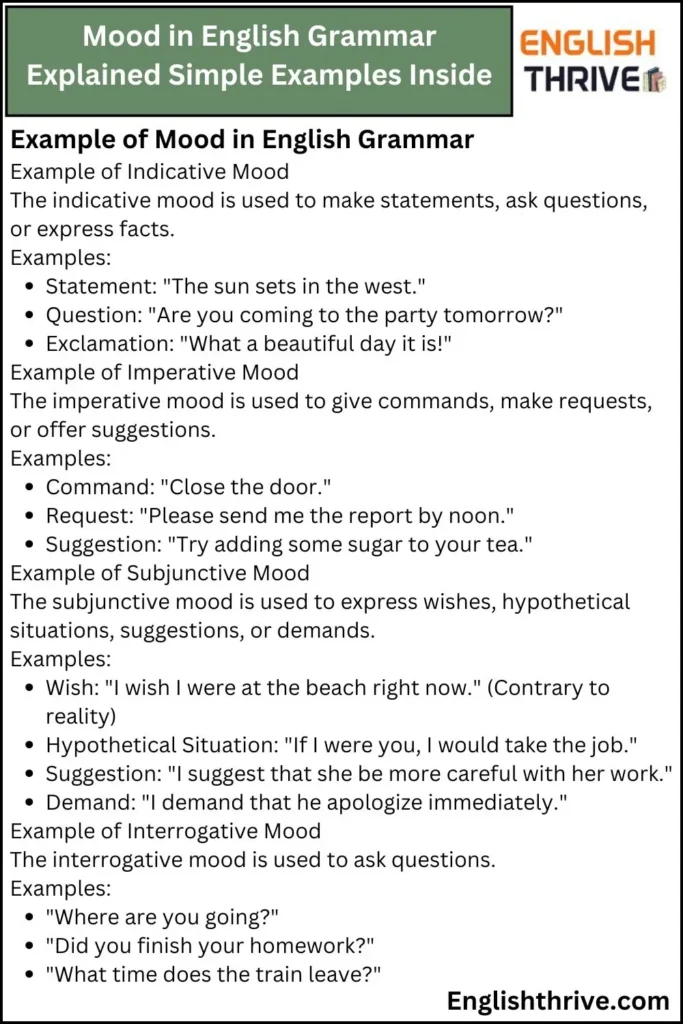Understanding mood in English grammar is crucial for both beginners and advanced learners of the language. While many of us are familiar with verb tenses and structures, mood often takes a backseat in learning. However, grasping the concept of mood can significantly improve your ability to communicate effectively. Mood in grammar is a reflection of the speaker’s attitude toward the action or state described in the sentence. It expresses how the speaker views the action—as a fact, a command, a wish, a suggestion, or a possibility.
In this comprehensive guide, we will explore the different moods in English grammar, including the most commonly used ones, and provide you with examples to help you master this aspect of the language.
Contents
ToggleWhat is mood in English grammar?
Mood in English grammar refers to the verb form that reflects the speaker’s intention or attitude toward the action. It indicates whether the statement expresses a fact, a command, a suggestion, or a hypothetical scenario. The mood determines the nature of the action and the way it is communicated, helping us convey nuances in our speech or writing.
English has several moods, each serving a different purpose. Here’s a breakdown of the most common moods:
1. Indicative Mood
The indicative mood is the most commonly used mood in English. It is used to state facts, ask questions, or express opinions. Essentially, it presents information as straightforward and factual.
Examples of Indicative Mood:
“The sun rises in the east.”
“She is reading a book.”
“Are you coming to the party tonight?”
This mood is used in declarative sentences (statements), interrogative sentences (questions), and exclamatory sentences. It simply states something as true or asks for clarification.
2. Imperative Mood
The imperative mood is used to issue commands, requests, or instructions. It is the mood of action and is typically used to tell someone to do something. The subject (you) is often implied in these sentences, though it can be explicitly stated.
Examples of Imperative Mood:
“Close the door.”
“Please sit down.”
“Don’t forget to bring your homework.”
In imperative sentences, the verb is typically in its base form (without “to”), and the subject is often omitted because it is understood to be “you.” This mood is direct and action-oriented.
3. Subjunctive Mood
The subjunctive mood is used to express wishes, desires, suggestions, or hypothetical situations. It often deals with situations that are not real, either because they are imagined, desired, or contrary to fact. The subjunctive is one of the most complex moods in English, and its usage has been declining, but it still plays an important role, particularly in formal writing.
Examples of Subjunctive Mood:
“I wish it were summer already.” (Wish contrary to reality)
“If I were rich, I would travel the world.” (Hypothetical situation)
“I suggest that he be more careful.” (Suggestion)
“It’s essential that she be here on time.” (Requirement)
In the subjunctive mood, verbs often appear in a form that differs from the usual conjugation. For example, we use “were” instead of “was” in certain situations (e.g., “If I were you…”). This is one of the most notable features of the subjunctive.
Additional Moods in English Grammar
While the three moods mentioned above are the most commonly recognized, English also has a couple of other moods that are less frequently discussed. These are the interrogative and conditional moods.
4. Interrogative Mood
The interrogative mood is used to form questions. It helps the speaker inquire about information, seeking answers. The verb structure in the interrogative mood often involves subject-verb inversion, where the auxiliary verb precedes the subject.
Examples of Interrogative Mood:
“What time is the meeting?”
“Did you finish your homework?”
“Are they coming over for dinner?”
This mood is essential for asking direct or indirect questions. It is marked by the use of question words (what, where, when, why) or auxiliary verbs (do, does, is, are).
5. Conditional Mood
The conditional mood expresses actions or states that depend on certain conditions or hypothetical situations. It often uses modal verbs like “would,” “might,” or “could” to indicate the possibility or hypothetical nature of the action.
Examples of Conditional Mood:
“If I had a million dollars, I would buy a house.”
“She could help you if she had more time.”
“I would have called you if I knew you were home.”
The conditional mood is used to express what could happen under specific circumstances, whether real or imagined. It often involves “if” clauses that describe the conditions for the action to take place.
Detailed Overview of Subjunctive Mood
The subjunctive mood deserves further attention because of its complexity and importance in expressing nuances in English.
The subjunctive is most commonly used in that-clauses after certain verbs and adjectives. Here are some key characteristics:
After Verbs of Suggestion, Demand, or Recommendation
“The doctor recommends that he take the medication.”
“She suggested that I be more careful.”
“I insist that they arrive on time.”
In Wishes and Desires
“I wish she were here.”
“If only I were a better cook.”
In Hypothetical Statements
“If I were you, I would apply for the job.”
“If it were sunny, we would go hiking.”
With “As If” or “As Though”
“She acts as if she were the boss.”
“It seems as though he were hiding something.”
Common Errors with Mood Usage
When it comes to mood, many learners and even native speakers make mistakes. The most common errors occur in the use of the subjunctive mood, especially with irregular verb forms like “were” and “be.”
Common Errors in the Subjunctive:
Using “was” instead of “were” in hypothetical situations.
Incorrect: “If I was rich, I would travel the world.”
Correct: “If I were rich, I would travel the world.”
Omitting the subjunctive form after verbs of demand or suggestion.
Incorrect: “I suggest she take a break.”
Correct: “I suggest she take a break.”
Confusing the indicative with the subjunctive in wishes.
Incorrect: “I wish I was there.”
Correct: “I wish I were there.
Example of Mood in English Grammar
Example of Indicative Mood
The indicative mood is used to make statements, ask questions, or express facts.
Examples:
Statement: “The sun sets in the west.”
Question: “Are you coming to the party tomorrow?”
Exclamation: “What a beautiful day it is!”
Example of Imperative Mood
The imperative mood is used to give commands, make requests, or offer suggestions.
Examples:
Command: “Close the door.”
Request: “Please send me the report by noon.”
Suggestion: “Try adding some sugar to your tea.”
Example of Subjunctive Mood
The subjunctive mood is used to express wishes, hypothetical situations, suggestions, or demands.
Examples:
Wish: “I wish I were at the beach right now.” (Contrary to reality)
Hypothetical Situation: “If I were you, I would take the job.”
Suggestion: “I suggest that she be more careful with her work.”
Demand: “I demand that he apologize immediately.”
Example of Interrogative Mood
The interrogative mood is used to ask questions.
Examples:
“Where are you going?”
“Did you finish your homework?”
“What time does the train leave?”

Example of Conditional Mood
The conditional mood is used to express actions or situations that are dependent on certain conditions, often involving the word “if.”
Examples:
Real Condition: “If it rains, we will cancel the picnic.”
Hypothetical Condition: “If I had more time, I would travel the world.”
Possible Condition: “You could go to the event if you get tickets.”
Conclusion On Mood in English
Understanding mood in English grammar is more than just knowing how to form different types of sentences; it’s about expressing intentions, emotions, and possibilities through language. The indicative mood is used for facts, the imperative mood for commands, and the subjunctive mood for wishes and hypothetical situations. Recognizing when and how to use these moods helps you convey your message more clearly and effectively, whether you’re writing or speaking.
As you continue to practice, you’ll develop a deeper understanding of mood, making your English more expressive and nuanced.

